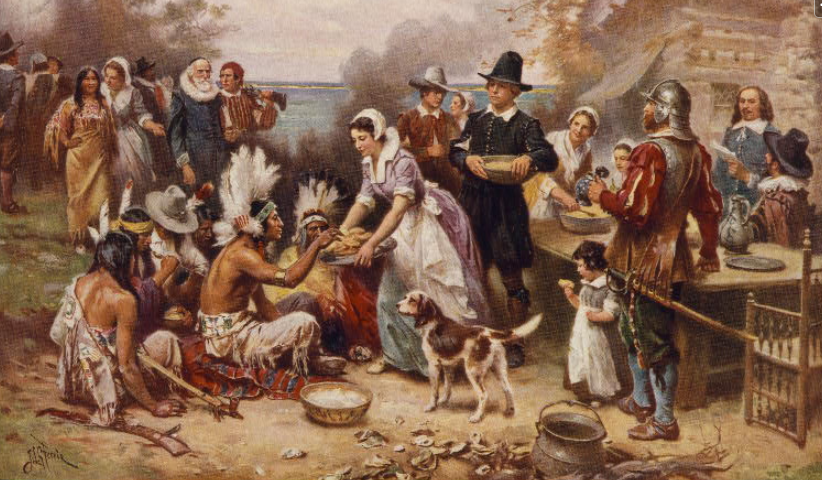The reality behind “The First Thanksgiving 1621”
Courtesy of Library of Congress
“First Thanksgiving 1621” by J.L.G. Ferris, 1912
December 8, 2022
As autumn comes to a close and the season starts to change, a day of gratitude and family finishes off the beloved season. Today’s Thanksgiving is a day to express thanks and enjoy feasts with friends and family. A similar perspective of the holiday is depicted in Jean Leon Gerome Ferris’s oil painting from 1912, The First Thanksgiving 1621. But how much of this famous painting was actually true?
Ferris’s painting shows the Wampanoag tribe and the Pilgrims feasting together on an autumn day. This celebration of fall harvests can be traced from not only the Pilgrims but also the Native Americans, and many important ancient civilizations as well. The friendly feasts in The First Thanksgiving 1621 displayed community and harmony between the Wampanoag tribe and the Pilgrims.
The native tribes of today’s Northeastern America had dealt with Europeans for many years, until 1616, when tradesmen from Europe introduced disease to the tribes, which killed a majority of the people. The Pilgrims, known as Separatists, which were a branch of Puritans. They were not welcome in England as King James had begun criminalizing Puritans in 1604, and so the Pilgrims left for Holland. There, they were not tied to a certain church and were free to practice their values. However, they were afraid of losing their identity, so they asked King James to let them establish their settlement in America where they could have even more religious freedom and flexibility.
The Pilgrims set sail to the Americas on the Mayflower and first landed in Cape Cod, where they were met with a harsher situation than they expected. They did not know how to fish or gather food and ultimately resorted to theft, which drastically limited their food supply. When they arrived in the Americas in the winter, they settled in Massachusetts and established New Plymouth. Many died by the time spring came.
In New Plymouth, they met Samoset, who informed them that the land belonged to the Wampanoags. The Pilgrims gave the Wampanoags a man to take hostage to build trust between the communities. The Pilgrims and Wampanoags were at peace when the Thanksgiving feast happened but that peace did not last long. As more and more English settlers came, they violated the peace treaty and treated the natives horribly.
Ferris’s oil painting from 1912, The First Thanksgiving 1621, is a small window onto what happened. It showcases the harmony and time of peace the natives and colonists shared, but it paints their relationship as a friendship when it was actually not. The Wamponoags were betrayed when their treaty of peace was violated, and while the painting shows how two groups can be in harmony, it falsely shows what historically happened.
The art piece itself does not display much of a friendship or interaction between the Wamponoag and the Pilgrims, as they are not even seated together. The Wamponoags are seated away on the floor and a Pilgrim woman is serving them food. The painting does not show how the Wampanoag helped the Pilgrims when they were starving, nor does it show how the Wamponoags were betrayed. Instead, it shows the Pilgrims giving the Wampanoag food and paints the Pilgrims as kind, despite their later betrayal.


